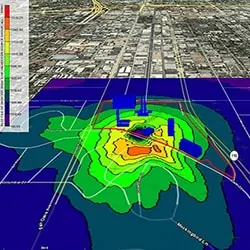

Using our modeling tools, the SCS Engineers team of modeling professionals can determine baseline pollutant concentrations, evaluate compliance with the national ambient air quality standards (NAAQS), analyze Prevention of Significant Deterioration 
We tailor the appropriate EPA-approved model(s), meteorological data, receptor placement, and model options (terrain, wind profile, downwash considerations, etc.) to develop a modeling protocol for your industry-specific application that will be accepted by the regulatory agency.
SCS Engineers prepares atmospheric dispersion modeling studies for air permit applications, for health risk assessments, and when requested by clients for other reasons. Modeling studies evaluate the impact of various release scenarios on local and regional air quality. Our engineers conduct the analyses using the dispersion models (Gaussian, numerical, statistical, or empirical) that best suit each scenario. For improved accuracy, we develop proprietary models according to the client’s specific needs and modeling conditions (e.g. neutral, buoyant, dense gas, etc.). We also validate dispersion models using specially developed techniques involving tracer gas sciences.
SCS continually strives to assist our clients in attaining and maintaining air quality standards by minimizing environmental and health impacts. Our professional engineers, chemists, scientists, and technicians are well-informed about regulatory requirements, saving you time and money.